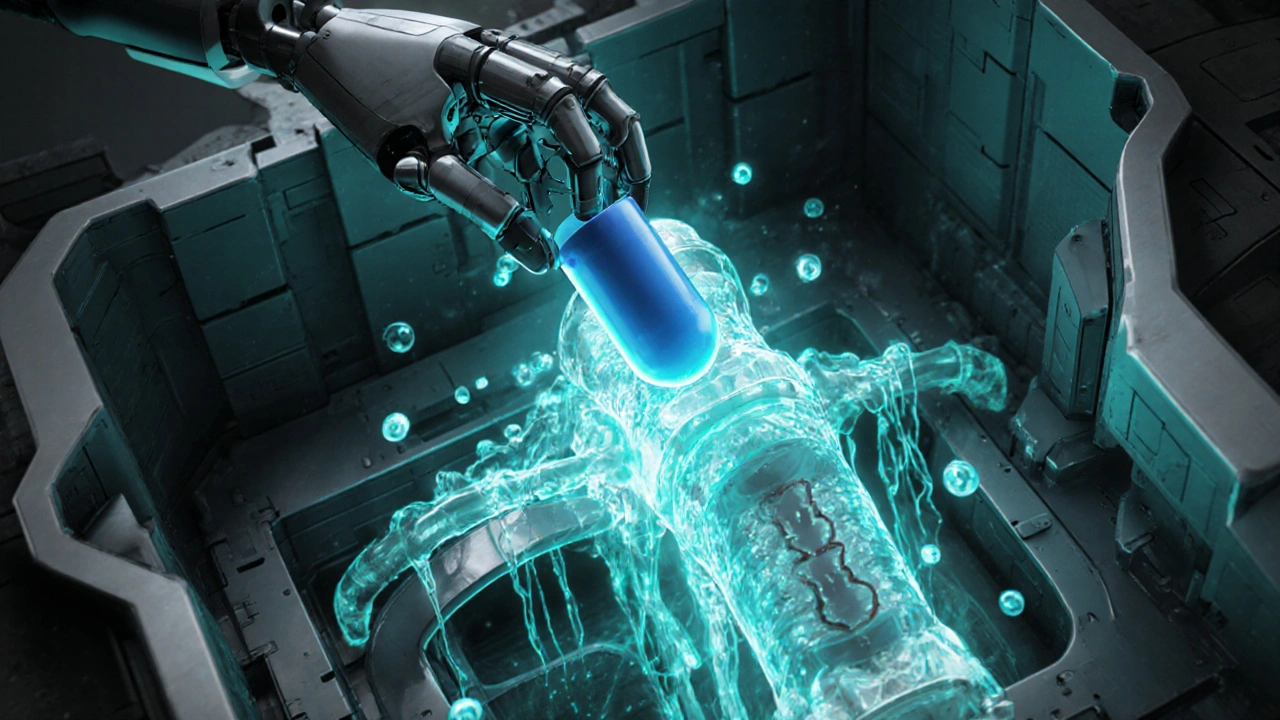Acetazolamide Kidney Risk Calculator
Dosage Guidance Calculator
Enter your eGFR to determine the appropriate acetazolamide dosage based on kidney function.
Important Notes
- Always consult your doctor before adjusting your acetazolamide dosage
- This calculator is for educational purposes only
- Regular kidney function monitoring is essential during therapy
When you hear the word acetazolamide, you probably think of mountain climbers or eye doctors, not kidneys. Yet this carbon‑carbon anhydrase inhibitor has a surprisingly direct line to how your kidneys work. If you’ve been prescribed the drug or are just curious, you’ll want to know what it does to your renal system, how to spot trouble, and what steps keep you safe.
What Acetazolamide Actually Is
Acetazolamide is a carbonic anhydrase inhibitor used as a diuretic, for glaucoma, altitude sickness, and certain seizure disorders. By blocking the enzyme carbonic anhydrase, it stops the kidneys from reabsorbing bicarbonate, which means more sodium, potassium and water flow out in the urine.
Because of that mechanism, the drug can change the balance of acids and bases in your blood-a fact that directly ties into kidney function.
How Kidneys Handle Acetazolamide
Kidney is the organ that filters blood, reclaims essential substances, and excretes waste. Acetazolamide works primarily in the proximal tubule, the first segment of the nephron, where carbonic anhydrase normally helps reclaim bicarbonate.
When the enzyme is inhibited, bicarbonate leaks into the urine, pulling water along. This causes a mild, reversible diuresis and a drop in blood pH (metabolic acidosis). The kidneys respond by increasing respiration and adjusting electrolyte handling.
For most healthy adults, the shift is modest and well‑tolerated. But if you already have reduced Glomerular Filtration Rate (GFR) or chronic kidney disease (CKD), that extra work can push the system over the edge.
Key Renal Side Effects to Watch
- Elevated Serum Creatinine levels, a signal that filtration is slowing.
- Development of Metabolic Alkalosis if the drug is stopped abruptly, because the kidneys overshoot bicarbonate reabsorption.
- Risk of Renal Tubular Acidosis type 2, where the proximal tubule can’t reclaim enough bicarbonate.
- Electrolyte imbalances-particularly low potassium (hypokalemia) and low sodium (hyponatremia).
- In rare cases, acute interstitial nephritis, an inflammation that can cause sudden kidney pain and decline.
Most of these issues surface within the first two weeks of therapy, which is why clinicians order baseline labs and a follow‑up check.
Who Is Most at Risk?
People with any of the following should discuss dosage tweaks with their doctor:
- Existing CKD (eGFR < 60mL/min/1.73m²).
- Uncontrolled diabetes, which already stresses the glomeruli.
- Concurrent use of other Diuretics like furosemide or thiazides.
- Medications that raise serum potassium, such as ACE inhibitors, because the combined effect can be unpredictable.
- Poor hydration status-dehydration narrows the filtering capacity.
Pregnant women and older adults also need careful monitoring, as kidney reserve naturally declines with age.

Dosage Guidelines for Safe Kidney Management
Standard adult dosing for altitude sickness is 250mg every 8hours, while glaucoma doses are often 250mg two times a day. For epilepsy, the dose can climb to 500mg three times daily.
If you have CKD, the general rule is to reduce the dose by 25‑50% and watch labs every 3‑5days. Here’s a quick cheat‑sheet:
- eGFR > 60mL/min: Full dose as prescribed.
- eGFR 30‑59mL/min: Cut dose in half; consider extending dosing interval.
- eGFR < 30mL/min: Use only if benefits clearly outweigh risks; monitor serum bicarbonate and creatinine weekly.
Never stop the drug suddenly unless a doctor tells you to. A gradual taper helps the kidneys readjust to normal bicarbonate reabsorption.
Monitoring: What Labs to Track
| Time Point | Test | Target / Warning Level |
|---|---|---|
| Baseline (before starting) | Serum Creatinine, eGFR, Serum Bicarbonate, Electrolytes (Na+, K+) | eGFR >60mL/min; Bicarbonate 22‑28mmol/L |
| Day 3‑5 | Serum Creatinine, Bicarbonate, K+ | Creatinine rise <0.3mg/dL; Bicarb >18mmol/L |
| Week 2 | All baseline labs + Urine pH | Urine pH 5‑6 (expected) |
| Monthly (if stable) | eGFR, Electrolytes | Stable within 5% |
If any value drifts out of range, the clinician may tweak the dose, add potassium supplements, or switch to a different diuretic.
Acetazolamide vs. Other Diuretics: Kidney Impact
| Diuretic | Primary Site of Action | Key Renal Side Effects | Typical Use Cases |
|---|---|---|---|
| Acetazolamide | Proximal tubule (carbonic anhydrase) | Metabolic acidosis, bicarbonate loss, mild GFR dip | Glaucoma, altitude sickness, epilepsy |
| Furosemide | Loop of Henle | Hypokalemia, ototoxicity, rapid GFR decline if over‑dosed | Fluid overload, heart failure |
| Hydrochlorothiazide | Distal convoluted tubule | Hypercalcemia, hyponatremia, modest GFR impact | Hypertension, mild edema |
Choosing the right diuretic often hinges on the specific renal risk profile. Acetazolamide’s unique acid‑base shift makes it a double‑edged sword: great for certain conditions, but not the first pick for patients with fragile kidneys.
Practical Tips for Patients on Acetazolamide
- Stay well‑hydrated. Aim for at least 2L of water a day unless your doctor says otherwise.
- Keep a symptom diary: note any muscle cramps, fatigue, or sudden weight changes.
- Watch for sweet‑or‑salty taste changes-these can signal electrolyte shifts.
- Don’t mix over‑the‑counter antacids without checking. They can raise serum bicarbonate and blunt the drug’s effect.
- Bring your latest lab results to every appointment; they guide dose adjustments.
If you notice dark urine, swelling, or a rapid weight gain, call your healthcare provider right away-those could be early signs of kidney trouble.

When to Stop or Switch Therapy
Stopping acetazolamide is usually safe once the underlying condition resolves (e.g., after descending from high altitude). However, abrupt cessation in chronic users can cause rebound metabolic alkalosis, which may stress the kidneys.
Consider switching to a thiazide or loop diuretic if:
- Serum creatinine rises more than 0.5mg/dL despite dose reduction.
- Persistent hypokalemia despite supplementation.
- Severe acidosis (bicarbonate <15mmol/L) develops.
A gradual taper-usually 25% reduction every 3days-helps the kidneys readjust smoothly.
Frequently Asked Questions
Frequently Asked Questions
Can acetazolamide cause permanent kidney damage?
In most people the effect is reversible. Permanent injury is rare and usually linked to high doses combined with other nephrotoxic drugs.
How often should I get blood tests while on the medication?
Baseline labs, then a repeat at days 3‑5, again at two weeks, and monthly after you’re stable. Your doctor may ask for more frequent checks if you have CKD.
Is it safe to take acetazolamide with ibuprofen?
Ibuprofen can reduce kidney blood flow, so pairing it with acetazolamide raises the risk of a creatinine spike. Talk to your doctor before mixing them.
What symptoms signal a problem with my kidneys?
Swelling in ankles, sudden weight gain, dark urine, persistent fatigue, or a sharp back pain near the kidneys should prompt an immediate check‑up.
Can I use acetazolamide while pregnant?
It’s classified as Pregnancy Category C. The benefits must outweigh the risks, and close monitoring is essential.
Why does my urine smell like something sweet?
Acetazolamide can raise urinary glucose excretion, giving a sweet scent. If you also notice increased thirst, check for diabetes.
Is there a way to protect my kidneys while staying on the drug?
Hydration, regular labs, low‑salt diet, and adding a potassium‑sparing agent when needed are the main safeguards.
Bottom Line
Acetazolamide can be a lifesaver for conditions like glaucoma or altitude sickness, but it talks directly to the kidneys’ acid‑base balance. Understanding how it works, who’s at risk, and how to monitor labs turns a potentially tricky medication into a manageable part of your health routine.
Talk openly with your prescriber, keep an eye on your labs, and stay hydrated. With those steps, you’ll get the benefits without surprising kidney setbacks.

Nis Hansen
October 17, 2025 AT 19:50Acetazolamide, though often celebrated for its role in altitude sickness, invites a deeper contemplation of renal homeostasis.
By inhibiting carbonic anhydrase in the proximal tubule, it subtly reshapes the acid‑base equilibrium that the kidneys so diligently maintain.
This perturbation obliges the nephrons to excrete bicarbonate, which in turn drags water and electrolytes along, a cascade reminiscent of philosophical cause and effect.
For patients with pristine glomerular filtration, the resulting mild metabolic acidosis is typically well tolerated, yet it remains a testament to the body's adaptability.
However, when renal reserve is already compromised, the additional workload can reveal hidden frailties, manifesting as rises in serum creatinine or electrolyte imbalances.
Monitoring should therefore commence with a baseline panel, followed by checks at days three to five and again at two weeks, to capture any early deviation.
Should creatinine climb beyond 0.3 mg/dL, clinicians ought to consider a dose reduction of twenty‑five to fifty percent, honoring the principle of minimal intervention.
Likewise, persistent hypokalemia despite supplementation signals a need to reassess the therapeutic strategy, perhaps switching to a thiazide diuretic.
The literature also warns of rare but serious interstitial nephritis, a reminder that even well‑intentioned agents can provoke immune‑mediated injury.
It is prudent to advise patients to maintain adequate hydration, aiming for at least two liters daily, unless contraindicated.
Equally important is the avoidance of abrupt discontinuation, which can precipitate rebound metabolic alkalosis and place further stress on the kidneys.
A tapered cessation over several days allows renal bicarbonate transport mechanisms to readjust gracefully.
In the broader philosophical sense, acetazolamide teaches us that therapeutic benefit and physiological disruption are two sides of the same coin.
By respecting dose adjustments, lab surveillance, and patient education, we can harness its advantages while safeguarding renal health.
Ultimately, the dialogue between drug and kidney mirrors the dialogical nature of human reason: dynamic, responsive, and ever‑seeking balance.
Natala Storczyk
October 26, 2025 AT 03:02Behold the mighty carbonic anhydrase inhibitor-Acetazolamide!
It storms the proximal tubule like a tactical avalanche, dumping bicarbonate into the urine and pulling water along in its wake!!!
The kidneys, those steadfast sentinels, scramble to keep the pH in check, while we watch electrolyte charts flicker like battlefield signals!
Do not be lulled into a false sense of security; the sudden dip in GFR can feel like a seismic shift in renal stability!!!
Patients with pre‑existing CKD are especially vulnerable, as the drug adds insult to injury, threatening to tip the balance into overt failure!
Vigilant monitoring is not a suggestion but a mandate-baseline labs, day‑3‑5 checks, and a two‑week reassessment are non‑negotiable!
If creatinine spikes, cut the dose or consider an alternate diuretic before the kidneys scream for help!
Remember, abrupt cessation is a recipe for rebound alkalosis, a dangerous roller‑coaster that can further jeopardize renal function!
Stay hydrated, stay aware, and let the labs guide you like a lighthouse through the storm!!!
nitish sharma
November 3, 2025 AT 10:14In reference to the preceding emphasis on diligent monitoring, it is essential to acknowledge that the pharmacokinetic profile of acetazolamide necessitates a judicious titration, particularly among individuals with compromised glomerular filtration. A reduction of twenty‑five to fifty percent of the conventional dose is advisable when eGFR falls within the thirty‑to‑fifty‑nine millilitre per minute range. Moreover, serial assessment of serum bicarbonate and potassium concentrations should be instituted at three‑day intervals during the initiation phase. Such a protocol aligns with the overarching principle of minimizing iatrogenic disturbance while preserving therapeutic efficacy. I trust these recommendations will prove beneficial to your clinical practice.
Rohit Sridhar
November 11, 2025 AT 17:26Hey folks, just wanted to drop a quick note of optimism!
Even though acetazolamide can be a bit of a heavyweight for the kidneys, most people bounce back with a little extra water and regular lab checks.
Think of it as a short‑term training camp for your renal system-once you’re past the first two weeks, the body usually settles into a new rhythm.
Keep an eye on potassium and don’t skip those potassium supplements if you feel a twinge of cramp.
And remember, if you ever feel off, your doc can always tweak the dose or switch you to something gentler like a thiazide.
Stay positive, stay hydrated, and you’ll get through this just fine!
Sarah Hanson
November 20, 2025 AT 00:38Totally agree with the upbeat tone-staying hydrated is key and those potassium supplements can make a world of difference. Also, keeping a quick symptom log helps you and the clinician spot any trends before they become a problem.
Nhasala Joshi
November 28, 2025 AT 07:50🧐 Let’s talk about the hidden agenda behind acetazolamide’s renal effects. The drug isn’t just a simple diuretic; it’s a carbonic anhydrase sabotage module, engineered to destabilize the acid‑base homeostasis and create a data vacuum for covert monitoring. 📊 When you see a sudden shift in bicarbonate levels, think of it as a signal flare for the shadow pharm‑network. The electrolyte fluctuations aren’t random-they’re a coded message. Keep your labs tight, stay skeptical, and don’t trust the “standard monitoring schedule” without questioning the source. 🌐💊